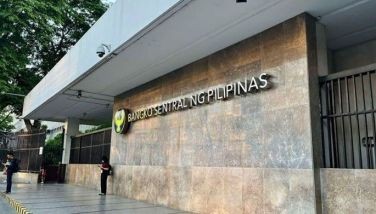ADB extends $160-M ‘poverty’ loan to RP
October 23, 2001 | 12:00am
The Asian Development Bank (ADB) will extend a loan assistance package amounting to at least $160 million to the Philippines annually strictly for poverty reduction programs.
The poverty-related loan facility is part of a $400-million yearly-loan assistance to the Philippines and a technical assistance program between $6 million and $9 million between 2002 and 2004.
"Forty-percent of lending will be for projects targeting poverty reduction. Close monitoring and analysis of the poverty situation and benchmark targets through extensive consultations will also be a key component of ADB’s assistance," it said in a statement during the poverty partnership agreement signing last week.
During the signing formalities, President Gloria Macapagal-Arroyo described poverty as "an outcome of a person’s entitlements or command over output, income assets and material goods."
Arroyo added that it could also be defined as "a process or situation of social exclusion, where individuals are constrained against full participation in social life due to barriers and race, gender, age, physical, handicaps, and of course, economic and physical resources."
To address poverty in the Philippines, and Arroyo administration has outlines four components, which are: (1) an economic philosophy with a social conscience; (2) a modernized agricultural sector founded on social equity; (3) a social bias toward the disadvantaged to balance our economic development plan; and (4) to raise the standards of government and society.
The ADB pledged to support the Arroyo government with a $1.1 billion project and program loan packages with 30 percent of the amount going to Mindanao.
The $1.1 billion covers the period of 2001 to 2004 focused on social sector programs, energy sector, and Mindanao. Social-related programs are basically poverty-alleviation one while the energy-related program is the $400-million Leyte-Mindanao interconnection project.
ADB president Tadao Chino in his speech said that proportions of Asians living in absolute poverty has gone down from more than half to a third, adult literacy has risen from 40 to 70 percent, and the average Asian whose life expectancy at birth was only 55 years, can now hope to live up to 68 years.
However, Chino said that to halve the absolute poverty by 2015, Asia must spearhead the challenge of poverty reduction and elimination as three-quarters of the world’s poor are located in that region.
That means among other things the development of institutions geared towards poverty elimination. But that should not end there.
The development of institutions is not an end all for people’s access to such entities.
"Poverty reduction frameworks and action plans exist but their impact is reduced by both inadequate and inappropriate development of institutions, and people’s lack of access to institutions," Chino said. "Poverty reduction strategies must tackle those problems that impede economic and social development."
He pledged to address the weaknesses of institutions and policies while supporting the poor by generating income and employment opportunities, and "providing education, health, and other essential services, and mitigating risks for the poor and especially vulnerable groups."
Aside from focusing on government’s role in poverty elimination, the ADB zeroed in on the private sector as another major component. Thus it is prepared to capitalize private investments through direct financing, credit enhancements, and risk mitigation instruments.
"Investments can be made in infrastructure facilities such as energy and telecommunications; financial institutions, particularly those specialized in small and medium sized enterprises; and pilot health and education projects," the ADB president added.
Todate, the Philippines has borrowed nearly $8 billion to finance key development projects. Last year, loan disbursements reached $228 million although the disbursement ratio was 11.3 percent, which is lower than the 20.5- percent ADB-wide average.
Since 1966, the ADB has extended a total of $4.9 billion to the Philippines covering 183 loans of which 60 were active at the end of 2000.
According to the ADB in its annual report for year 2000 released yesterday, contract awards totaled $176.6 million or a cumulative amount of $4.6 billion. The contract award ratio for 2000 was 11.1 percent lower than the ADB average of 21 percent. – Ted Torres
The poverty-related loan facility is part of a $400-million yearly-loan assistance to the Philippines and a technical assistance program between $6 million and $9 million between 2002 and 2004.
"Forty-percent of lending will be for projects targeting poverty reduction. Close monitoring and analysis of the poverty situation and benchmark targets through extensive consultations will also be a key component of ADB’s assistance," it said in a statement during the poverty partnership agreement signing last week.
During the signing formalities, President Gloria Macapagal-Arroyo described poverty as "an outcome of a person’s entitlements or command over output, income assets and material goods."
Arroyo added that it could also be defined as "a process or situation of social exclusion, where individuals are constrained against full participation in social life due to barriers and race, gender, age, physical, handicaps, and of course, economic and physical resources."
To address poverty in the Philippines, and Arroyo administration has outlines four components, which are: (1) an economic philosophy with a social conscience; (2) a modernized agricultural sector founded on social equity; (3) a social bias toward the disadvantaged to balance our economic development plan; and (4) to raise the standards of government and society.
The ADB pledged to support the Arroyo government with a $1.1 billion project and program loan packages with 30 percent of the amount going to Mindanao.
The $1.1 billion covers the period of 2001 to 2004 focused on social sector programs, energy sector, and Mindanao. Social-related programs are basically poverty-alleviation one while the energy-related program is the $400-million Leyte-Mindanao interconnection project.
ADB president Tadao Chino in his speech said that proportions of Asians living in absolute poverty has gone down from more than half to a third, adult literacy has risen from 40 to 70 percent, and the average Asian whose life expectancy at birth was only 55 years, can now hope to live up to 68 years.
However, Chino said that to halve the absolute poverty by 2015, Asia must spearhead the challenge of poverty reduction and elimination as three-quarters of the world’s poor are located in that region.
That means among other things the development of institutions geared towards poverty elimination. But that should not end there.
The development of institutions is not an end all for people’s access to such entities.
"Poverty reduction frameworks and action plans exist but their impact is reduced by both inadequate and inappropriate development of institutions, and people’s lack of access to institutions," Chino said. "Poverty reduction strategies must tackle those problems that impede economic and social development."
He pledged to address the weaknesses of institutions and policies while supporting the poor by generating income and employment opportunities, and "providing education, health, and other essential services, and mitigating risks for the poor and especially vulnerable groups."
Aside from focusing on government’s role in poverty elimination, the ADB zeroed in on the private sector as another major component. Thus it is prepared to capitalize private investments through direct financing, credit enhancements, and risk mitigation instruments.
"Investments can be made in infrastructure facilities such as energy and telecommunications; financial institutions, particularly those specialized in small and medium sized enterprises; and pilot health and education projects," the ADB president added.
Todate, the Philippines has borrowed nearly $8 billion to finance key development projects. Last year, loan disbursements reached $228 million although the disbursement ratio was 11.3 percent, which is lower than the 20.5- percent ADB-wide average.
Since 1966, the ADB has extended a total of $4.9 billion to the Philippines covering 183 loans of which 60 were active at the end of 2000.
According to the ADB in its annual report for year 2000 released yesterday, contract awards totaled $176.6 million or a cumulative amount of $4.6 billion. The contract award ratio for 2000 was 11.1 percent lower than the ADB average of 21 percent. – Ted Torres
BrandSpace Articles
<
>
- Latest
Latest
Latest
December 4, 2024 - 4:05pm
December 4, 2024 - 4:05pm
November 25, 2024 - 9:35am
November 25, 2024 - 9:35am
October 8, 2024 - 7:00am
October 8, 2024 - 7:00am
September 18, 2024 - 10:00am
By May Dedicatoria | September 18, 2024 - 10:00am
September 18, 2024 - 8:00am
September 18, 2024 - 8:00am
Recommended






























